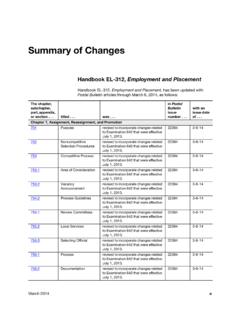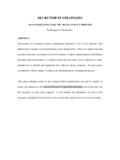Transcription of Rent Regulation Individual Apartment …
1 Volume 256 No. 3 WedNesday, July 6, 2016www. of the major features of the Rent Stabilization Law (RSL), and one much beloved by landlords, is the landlord s right to add new equipment and improvements to an Apartment , usually during a vacancy. These improvements are known as Individual Apartment Improvements, or IAIs. Formerly, a landlord could increase the rent by 1/40 of the cost of the IAIs; since 2011, the increases are 1/40 or 1/60 of the cost, depending upon the size of the building. Statutes and RegulationsThe RSL of 1969 did not provide for IAI rent increases. Instead, the basis for such increases is found in the Code of the Rent Stabilization Association (the RSA Code), which was adopted pursuant to the pow-ers granted to the RSA in the RSL. Section 20(C)(1) of the RSA Code stated that where there is:..an increase in dwell-ing space or the instal-lation of new equipment or improvements in a particular dwelling unit other than a Major Capital Improvement, the monthly stabilization rent for the dwelling unit shall be increased by 1/40 of the total cost of such added dwelling space, equipment or improvements, including the cost of installation thereof; provided, however, that such an increase shall not be collectible during the term of a lease then in effect or any renewal thereof except upon the written consent of the language is found in Section (a)(1) of the Rent Stabilization Code, which was first enacted in increases were first authorized by statute pursuant to the Rent Reg-ulation Reform Act of 1993 (L.)
2 1993, ch 253). Section 19 of the Act added Section 26-511(c)(13) to the RSL to allow for rent increases where:..there has increase in the services, or installation of new equipment or in or to a ten-ant s housing accommodation, on written tenant consent to the increase. In the case of a vacant housing accommodation, tenant WarreN a. estis is a founding member of Rosenberg & Estis. Jeffrey turkel is a member at the RegulationIndividual Apartment Improvements: an OverviewBy Warren a. estisAnd Jeffrey turkelFormerly, a landlord could in-crease the rent by 1/40 of the cost of the improvement to the Apartment ; since 2011, the in-creases are 1/40 or 1/60 of the cost, depending upon the size of the building. RoMoLoTAvAnI WedNesday, July 6, 2016consent shall not be required. The permanent increase in the legal regulated rent for the affected housing accommodation shall be one-fortieth of the total cost incurred by the landlord in providing , including the cost of installation, but excluding finance charges.
3 Provided further that an owner who is entitled to a rent increase pursuant to this paragraph shall not be entitled to a further rent increase based upon the instal-lation of similar the useful life of such to the Rent Act of 2011 (L. 2011, ch 97, pt. B), the Legisla-ture amended RSL 26-511(c)(13) to provide that the permanent rent increase shall be 1/40 of the total cost in buildings with 34 or fewer housing accommodations, and shall be the case of a building with more than thirty five housing such permanent increase takes effect on or after September twenty-four, two thousand eleven .. What Qualifies as an IAI?Typical IAIs include kitchen appliances, kitchen cabinets, bath-room fixtures, and new flooring. Although the vast majority of IAI work is performed in vacant apart-ments because tenant consent is not required where the apart-ment is vacant much of the work that landlords routinely perform in vacant apartments is deemed normal maintenance and repairs, rather than the installation of new equipment or improvements.
4 Thus, IAI increases will not be granted for such routine work as painting, skim-coating, scraping, plastering, and the polyurethaning of floors. See Mayfair York Co. v. New York State Div. of Hous. and Community Renewal, 240 AD2d 158 (1st Dept. 1997).DHCR s operational Bulletin 2016-1, issued in May of 2016, sets forth an expanded list of items that may qualify as an IAI, includ-ing new subflooring, new carpet-ing, new built-in clothing closets, new storm windows, new securi-ty alarm, painting and plastering if part of a major renovation, and installation of sheetrock if done throughout the Apartment . Practitioners are advised to con-sult operational Bulletin 2016-1 because it constitutes, for better or worse, DHCR s latest policies concerning of Proof and Costnot surprisingly, the burden of proving the legitimacy of an IAI increase is on the landlord. See 985 Fifth Ave. Inc. v. New York State Div. of Hous. and Community Renewal, 171 AD2d 572 (1st Dept.)
5 1991). Pursuant to operational Bulletin 2016-1, proof of payment should include: (1) cancelled checks con-temporaneous with the completion of the work; (2) invoices marked paid; (3) signed contracts; and (4) a contractor s affidavit stating that the installation was complet-ed and paid in full. Because the four-year statute of limitations on rent overcharge claims has virtu-ally ceased to exist, landlords are advised to maintain such proof in who fail to prove IAIs may be liable for treble damages, especially where DHCR finds that the landlord had inflated costs, misrepresented the scope of work, or has not testified credibly. See Riverside Equities, LLC v. New York State Div. of Hous. and Community Renewal, 58 AD3d 534 (1st Dept. 2009).It is not always the case that the landlord s documentation breaks down the scope of work between actual improvements and ordinary repairs. In Jemrock Realty Co., LLC v. Krugman, 13 nY3d 924, 926 (2010), the Court of Appeals held that in such instances.
6 The resolution of that issue is not governed by any inflexible rule either that a landlord is always required, or that it is never required, to submit an item-by-item breakdown, showing an allo-cation between improvements and repairs, where the landlord has engaged in extensive renova-tion work. The question is one to be resolved by the factfinder in Landlords who fail to prove IAIs may be liable for treble damages, especially where DHCR finds that the landlord inflated costs, mis-represented the scope of work, or has not testified credibly. WedNesday, July 6, 2016the same manner as other issues, based on the persuasive force of the evidence submitted by the of FundsSometimes a landlord improves a vacant Apartment following a fire or other casualty. In Nagobich v. New York State Div. of Hous. and Com-munity Renewal, 200 AD2d 388 (1st Dept. 1994), the First Department affirmed DHCR s interpretation of RSA Code Section 20(C)(1) as not allowing a landlord to collect IAI increases where the work is paid from insurance proceeds:The cost of insurance is already factored into the calculation of the regulated rent, and thus the insurance recovery does not rep-resent an outlay of new capital that may be recouped by perma-nently adding 1/40 of the cost of the expenses to the rent.
7 The statutory scheme permits a rent increase only for an improve-ment , and rationally does not include repairs paid for by insur-ance policies already financed by the rents Labor Costsnot surprisingly, a landlord will frequently ask the building superin-tendent to perform certain IAI work, such as the installation of new cabi-nets or flooring. The question then arises as to how to value the super-intendent s labor when calculating the lawful cost of the IAI. Pursuant to longstanding DHCR practice, the issue comes down to how the super-intendent is compensated. In Matter of 299 Adelphi Associates, DHCR Adm. Rev. Dckt. no. CG-210286-Ro, issued , 1995, DHCR ruled that where work is performed by a superinten-dent, an owner must show that the work was done and paid for separate and apart from the superintendent s ordinary duties at the subject prem-ises. Thus, if making improvements is part of the superintendent s job and is reflected in the superinten-dent s compensation, no IAI increas-es will be allowed for such labor.
8 If the superintendent is paid for this extra work above and beyond his or her usual paycheck, an increase will be permitted, but proof of such payment will be required. In many instances, the landlord will use its own contracting com-pany to perform the work, which raises the specter of inflated labor costs and other charges. In opera-tional Bulletin 2016-1, in the section captioned Identity of Interest, DHCR states that it will require additional proof where it appears that the owner and/or managing agent have a financial interest, or family ties, with an entity receiving payment for an IAI. Additional proof will also be required where there is evidence of side deals, agree-ments or contracts. DHCR does not specify the additional proof that it will require, but it can be assumed that such proof will vary depending on the peculiar facts of each disputes usually occur in the context of overcharge cases before DHCR. It is well settled, however, that courts have jurisdiction to decide allegations of overcharge involving IAI increases.
9 In Rocka-way One Co. v. Wiggins, 35 AD2d 36, 42-43 (2d Dept. 2006), the Second Department confirmed that DHCR does not have exclusive jurisdiction over such matters: The issues presented with respect to an overcharge based on an allegedly improper IAI increase are not foreign to the courts. Essentially, in evalu-ating the legitimacy of an IAI increase, the court is required to determine (1) whether the owner made the improvements to the Apartment during the rel-evant time period, (2) whether those improvements constitute legitimate Individual Apartment improvements within the mean-ing of the regulations, (3) the total cost of the improvements, (4) one-fortieth of that cost, and (5) the sum of one-fortieth of the costs plus the monthly rent level after any other increases to which the owner may be entitled. While it is the regula-tions provide for the exercise of some discretion in determining the availability and extent of an IAI increase, the limited scope of that discretion does not require administrative review as a predi-cate for judicial consideration (internal citations omitted).
10 Reprinted with permission from the July 6, 2016 edition of the NEW YORK LAW JOURNAL 2016 ALM Media Properties, LLC. All rights reserved. Further duplication without permission is prohibited. For information, contact 877-257-3382 or # 070-07-16-08





